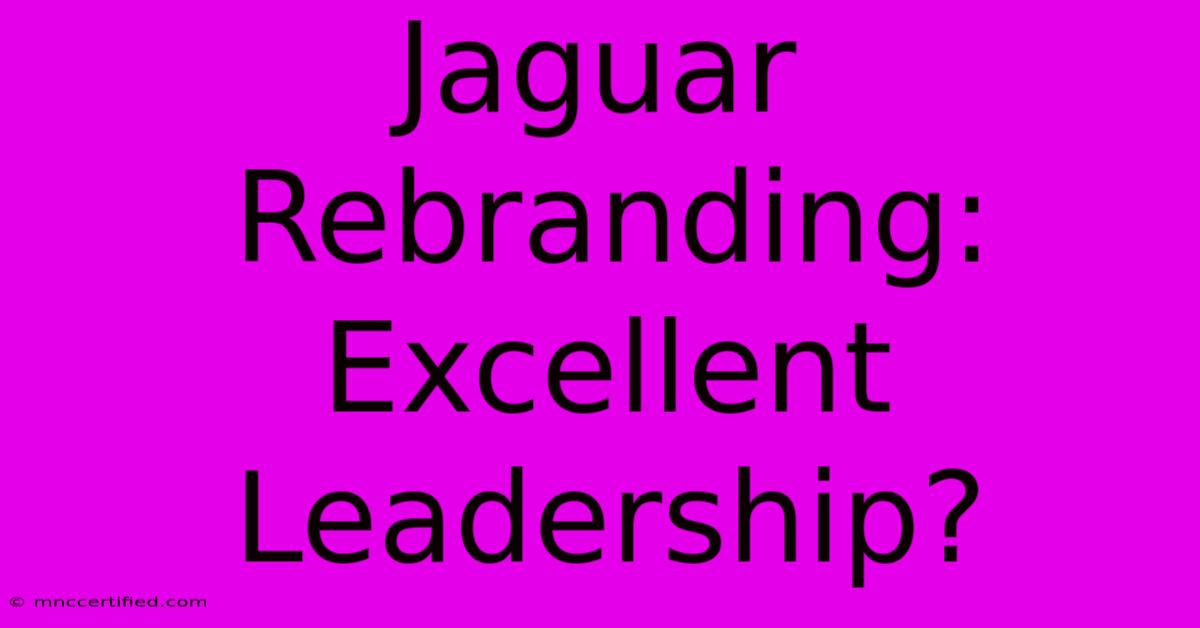Jaguar Rebranding: Excellent Leadership?

Table of Contents
Jaguar Rebranding: Excellent Leadership? A Critical Analysis
Jaguar's recent rebranding efforts have sparked considerable debate. Was it a stroke of genius showcasing excellent leadership, or a misguided gamble that could ultimately harm the brand? This article delves into the details, examining the rebranding strategy, its impact, and ultimately assessing whether it reflects excellent leadership.
The Rebranding: A Bold New Look
Jaguar's rebranding isn't just a logo tweak; it's a comprehensive overhaul encompassing visual identity, messaging, and brand positioning. The new logo, a simplified and more modern interpretation of the leaping jaguar, is perhaps the most visible change. This minimalist approach aims to project a sense of modern luxury and sophistication, moving away from the more traditional, somewhat dated image the brand previously held. The accompanying marketing campaigns emphasize sustainability, innovation, and a focus on electric vehicles, aligning with current consumer trends and industry shifts.
Key Changes and Their Implications:
- Simplified Logo: The minimalist design aims for broader appeal and a cleaner, more contemporary aesthetic. However, some critics argue it lacks the distinctive character of the previous logo, potentially diluting brand recognition.
- Electric Vehicle Focus: This is a crucial strategic move, responding to the growing demand for EVs and positioning Jaguar as a leader in sustainable luxury. The success of this strategy will depend heavily on the market reception of their new electric models.
- Brand Messaging: The shift towards emphasizing sustainability and innovation is a positive step, resonating with environmentally conscious consumers. Effective communication of this message will be vital for attracting this key demographic.
Was it Excellent Leadership? A Multifaceted Perspective
Determining whether Jaguar's rebranding reflects excellent leadership requires a nuanced perspective. On one hand, the rebranding demonstrates boldness and vision. It acknowledges the need for adaptation in a rapidly evolving automotive market and proactively positions Jaguar for future success. The focus on EVs shows foresight and a willingness to embrace change, crucial for long-term viability in the industry.
However, the success of any rebranding hinges on its execution and market reception. Simply making changes isn't enough; those changes need to resonate with consumers and drive positive business outcomes. The risk inherent in a significant rebranding, particularly one as bold as Jaguar's, is that it could alienate loyal customers while failing to attract new ones. Maintaining brand recognition while undergoing such a transformation is a significant challenge.
Potential Risks and Challenges:
- Loss of Brand Identity: The simplified logo might not be memorable enough, leading to a decrease in brand recognition and recall.
- Market Response: The success of the rebranding ultimately depends on consumer acceptance of the new image, messaging, and electric vehicle lineup.
- Competition: The luxury electric vehicle market is highly competitive. Jaguar will need to differentiate itself effectively to gain market share.
Conclusion: A Gamble with Potential for Reward
Jaguar's rebranding is a significant gamble, a bold strategic move that reflects a certain level of excellent leadership in its ambition and forward-thinking approach. Whether it ultimately proves successful remains to be seen. The long-term impact will depend on factors beyond leadership's control, such as consumer reception, market trends, and the success of its electric vehicle strategy. However, the courage to embrace significant change in a fiercely competitive market demonstrates a proactive and visionary leadership style – a crucial element for success in the long run. Only time will tell if this calculated risk pays off.
Keywords: Jaguar, rebranding, logo redesign, electric vehicles, luxury cars, brand strategy, marketing, leadership, automotive industry, sustainability, innovation, brand identity, modern luxury, consumer trends, brand recognition, market response, competitive advantage.

Thank you for visiting our website wich cover about Jaguar Rebranding: Excellent Leadership?. We hope the information provided has been useful to you. Feel free to contact us if you have any questions or need further assistance. See you next time and dont miss to bookmark.
Featured Posts
-
Janettes Savage Comment To Aljaz
Nov 21, 2024
-
Insurance Statute Of Limitations
Nov 21, 2024
-
Type Of Insurance Crossword Clue
Nov 21, 2024
-
Home Insurance Palm Beach County
Nov 21, 2024
-
Rhino Security Deposit Insurance
Nov 21, 2024